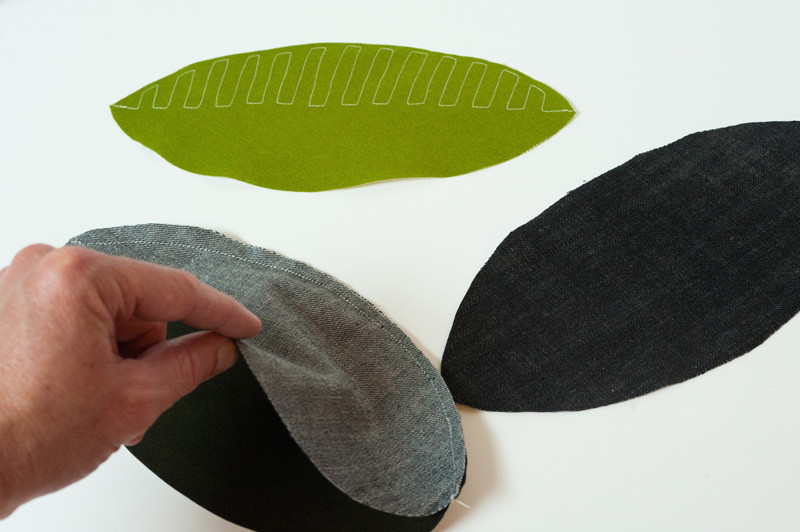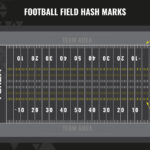Are you looking for a fun and engaging project? Learn how to make a football with this step-by-step guide, perfect for all ages and skill levels! Creating your own football is a rewarding experience, and CAUHOI2025.UK.COM is here to help you every step of the way. Discover different methods, tips, and materials to craft the perfect DIY football and enjoy hours of fun.
1. Understanding the Basics of Football Construction
Before diving into the crafting process, it’s helpful to understand the basic construction of a football. A standard American football is prolate spheroid, characterized by its elongated shape with pointed ends. While professional footballs adhere to strict regulations, such as those set by the National Football League (NFL), DIY footballs offer more flexibility in terms of size, materials, and design.
1.1. Anatomy of a Football
- Panels: These are the individual pieces of material that are sewn together to form the football’s body. Traditionally, footballs have four panels, but this can vary in DIY projects.
- Laces: These provide a grip for throwing and catching the ball.
- Bladder: This inflatable component inside the football gives it shape and bounce.
- Stuffing (for soft footballs): Instead of a bladder, soft footballs are filled with stuffing, such as batting or fabric scraps, making them safe for indoor use or for young children.
1.2. Material Selection
Choosing the right materials is crucial for creating a durable and enjoyable football.
- Leather: This is the traditional material for footballs, offering excellent grip and durability. However, it can be more expensive and difficult to work with for beginners.
- Synthetic Leather: A more affordable and accessible alternative to genuine leather. It provides good grip and is easier to sew.
- Fabric: Cotton, denim, felt, and fleece are popular choices for soft footballs. They are easy to sew and come in a variety of colors and patterns.
- Stuffing: Polyester fiberfill is a common choice for stuffing soft footballs. You can also use fabric scraps or even plastic grocery bags for a more eco-friendly option.
2. Method 1: Sewing a Fabric Football
This method is perfect for beginners and anyone looking to create a soft, safe football for kids or indoor play.
2.1. Gathering Your Supplies
- Fabric (cotton, denim, felt, or fleece)
- Scissors
- Sewing machine or needle and thread
- Stuffing (polyester fiberfill, fabric scraps, or plastic bags)
- Paper for creating a pattern
- Pencil or marker
- Ruler
- Pins
2.2. Creating a Football Pattern
- Draw an Oval: On a piece of paper, draw an oval shape that is the desired size and shape for your football. A typical size is about 11-12 inches long.
- Divide the Oval: Divide the oval in half lengthwise. Then, create a slightly curved line on each half to form the panels of the football.
- Cut Out the Pattern: Cut out the pattern pieces. These will be used to cut the fabric for your football.
2.3 Cutting the Fabric
- Pin the Pattern: Pin the paper pattern pieces to your chosen fabric.
- Cut the Fabric: Cut out four panels from the fabric, using the paper pattern as a guide.
- Seam Allowance: Remember to add a seam allowance (about 1/4 inch) around each panel.
2.4. Sewing the Panels Together
- Sew Two Panels: Place two fabric panels right sides together and sew along one edge.
- Add the Third Panel: Attach the third panel to one of the sewn panels, sewing along the edge.
- Attach the Fourth Panel: Attach the fourth panel, leaving a gap for turning and stuffing. When sewing the last seam, leave an opening of about 3-4 inches. This opening will be used to turn the football right-side out and stuff it.
- Turn Right Side Out: Turn the football right-side out through the opening.
2.5. Stuffing the Football
- Stuff the Football: Fill the football with your chosen stuffing material. Make sure to stuff it firmly to give it a good shape.
- Close the Opening: Once the football is stuffed to your liking, hand-sew the opening closed using a hidden stitch.
 Sewing fabric panels to make a DIY football
Sewing fabric panels to make a DIY football
2.6. Optional: Adding Laces
- Cut a Strip of Fabric: Cut a strip of fabric (felt or faux leather works well) about 6 inches long and 1 inch wide.
- Create Lace Holes: Make small slits along the center of the strip to resemble laces.
- Attach the Laces: Hand-sew the lace strip onto the football’s surface, centering it along the top.
3. Method 2: Upcycling Denim into a Football
This method is a great way to reuse old jeans and create a unique and durable football.
3.1. Gathering Supplies
- Old jeans
- Scissors
- Sewing machine or needle and thread
- Stuffing (fabric scraps or polyester fiberfill)
- Paper for creating a pattern
- Pencil or marker
- Ruler
- Pins
3.2. Preparing the Denim
- Cut the Jeans: Cut the legs off the old jeans.
- Open the Seams: Open the seams of the jeans to create large pieces of denim fabric.
3.3. Cutting the Panels
- Use a Pattern: Use the same pattern as in Method 1 to cut out four panels from the denim fabric.
- Seam Allowance: Remember to add a seam allowance (about 1/4 inch) around each panel.
3.4. Sewing the Denim Panels
- Sew Two Panels: Place two denim panels right sides together and sew along one edge.
- Add the Third Panel: Attach the third panel to one of the sewn panels, sewing along the edge.
- Attach the Fourth Panel: Attach the fourth panel, leaving a gap for turning and stuffing. When sewing the last seam, leave an opening of about 3-4 inches. This opening will be used to turn the football right-side out and stuff it.
- Turn Right Side Out: Turn the football right-side out through the opening.
3.5. Stuffing the Denim Football
- Stuff the Football: Fill the football with your chosen stuffing material. Make sure to stuff it firmly to give it a good shape.
- Close the Opening: Once the football is stuffed to your liking, hand-sew the opening closed using a hidden stitch.
3.6. Optional: Adding Decorative Stitching
- Decorative Stitching: Use a sewing machine to add decorative stitching along the seams of the football. This can add a unique and personalized touch.
 Sewing denim panels together to make a DIY football
Sewing denim panels together to make a DIY football
4. Method 3: Making a Mini Football with Felt
This method is a quick and easy way to create a small, soft football, ideal for younger children.
4.1. Gathering Supplies
- Felt sheets in brown or desired colors
- Scissors
- Needle and thread
- Stuffing (polyester fiberfill)
- Paper for creating a pattern
- Pencil or marker
- Ruler
4.2. Cutting the Felt Panels
- Create a Pattern: Create a paper pattern for a smaller football panel (about 6-8 inches long).
- Cut the Felt: Use the pattern to cut out four panels from the felt sheets.
4.3. Sewing the Felt Panels
- Sew Two Panels: Place two felt panels together and sew along one edge.
- Add the Third and Fourth Panels: Continue adding the panels, leaving a small opening for stuffing.
- Turn and Stuff: Turn the football partially right-side out and stuff with polyester fiberfill.
- Close the Opening: Hand-sew the opening closed.
4.4. Adding Laces
- Cut Felt Laces: Cut a small strip of white felt and fringe the edges to resemble laces.
- Attach the Laces: Glue or sew the felt laces onto the top of the football.
5. Tips for a Perfect DIY Football
- Use a Template: A template ensures consistent panel shapes for a professional look.
- Reinforce Seams: Double-stitch seams for added durability, especially if using heavier fabrics like denim.
- Vary Stuffing: Mix stuffing materials like fabric scraps and fiberfill for unique weight and texture.
- Personalize: Add names, numbers, or team logos with fabric markers or embroidery.
- Proper Tools: Use sharp scissors and the right needle for your chosen fabric to make sewing easier.
- Seam Allowance: Maintain consistent seam allowance for uniform panel connections.
6. Creative Ideas for Your DIY Football
- Team Colors: Use fabric in your favorite team’s colors to show your support.
- Personalized Names: Add a child’s name to create a special and unique toy.
- Holiday Themes: Create footballs with holiday-themed fabrics, like Halloween or Christmas patterns.
- Sensory Footballs: Add crinkly material or small bells inside the stuffing to create a sensory toy for babies.
7. Safety Considerations
- Supervise Children: Always supervise young children when they are playing with homemade footballs.
- Avoid Small Parts: Make sure that any embellishments, such as buttons or beads, are securely attached to prevent choking hazards.
- Use Non-Toxic Materials: Choose non-toxic fabrics and stuffing materials, especially for toys intended for young children.
- Inspect Regularly: Regularly inspect the football for any signs of wear and tear, and repair any damage promptly.
8. The Benefits of DIY Projects
Engaging in DIY projects like making your own football offers numerous benefits.
- Creativity and Self-Expression: DIY projects allow you to express your creativity and personalize items to your liking.
- Cost-Effective: Making your own items can often be more cost-effective than buying them retail.
- Skill Development: DIY projects help you develop new skills, such as sewing, crafting, and problem-solving.
- Mindfulness and Relaxation: Engaging in hands-on activities can be a great way to relax and reduce stress.
- Sense of Accomplishment: Completing a DIY project provides a sense of accomplishment and pride.
9. Why Choose CAUHOI2025.UK.COM for Your DIY Needs?
At CAUHOI2025.UK.COM, we are committed to providing you with accurate, reliable, and easy-to-understand information to support your DIY projects and answer all your questions. We understand the challenges of finding trustworthy information online, and we strive to be your go-to source for expert advice and practical solutions.
Whether you are looking for detailed instructions, creative ideas, or troubleshooting tips, CAUHOI2025.UK.COM is here to help you every step of the way. Our team of experts is dedicated to researching and compiling the most up-to-date information from reputable sources, ensuring that you have the knowledge and confidence to tackle any project.
10. Frequently Asked Questions (FAQ)
Q1: What is the best fabric for making a durable football?
A1: For a durable football, consider using denim, canvas, or synthetic leather. These materials can withstand rough play and last longer than softer fabrics like cotton or felt.
Q2: Can I use a sewing machine for all steps, or are hand-sewing needed?
A2: While a sewing machine is great for most seams, hand-sewing is often necessary for closing the stuffing hole and adding details like laces.
Q3: What can I use for stuffing if I don’t have polyester fiberfill?
A3: You can use fabric scraps, old clothes, plastic bags, or even cotton balls as alternatives to polyester fiberfill.
Q4: How do I make sure my football has a good shape?
A4: Use a well-defined pattern, cut accurately, and stuff the football firmly and evenly to maintain a good shape.
Q5: Can I wash a fabric football?
A5: It depends on the fabric and stuffing. Hand-washing is generally safer than machine washing. If machine washing, use a gentle cycle and air dry.
Q6: How do I add weight to my football?
A6: You can add weight by mixing in materials like rice, beans, or sand (in a sealed bag) with the stuffing. Be cautious with children.
Q7: What size should I make the football for a toddler?
A7: A mini football about 6-8 inches long is a good size for a toddler, making it easier for them to handle.
Q8: How can I personalize my football?
A8: Use fabric markers, embroidery, or iron-on patches to add names, numbers, or team logos to your football.
Q9: Is it cheaper to make a football than to buy one?
A9: Yes, especially if you use recycled materials. The cost savings can be significant compared to buying a new football.
Q10: Where can I find more DIY project ideas?
A10: Visit CAUHOI2025.UK.COM for a wide range of DIY project ideas, tips, and tutorials.
Conclusion
Making your own football is a fun and rewarding project that can be enjoyed by people of all ages and skill levels. Whether you choose to sew a fabric football, upcycle old denim, or create a mini felt football, the possibilities are endless. By following the steps and tips outlined in this guide, you can create a unique and personalized football that is perfect for playing catch in the backyard or displaying your team spirit.
Remember, CAUHOI2025.UK.COM is here to support you every step of the way. If you have any questions or need further assistance, don’t hesitate to reach out to us.
Ready to start your DIY football project? Visit CAUHOI2025.UK.COM today for more tips, tutorials, and expert advice!
For further inquiries or assistance, you can reach us at:
Equitable Life Building, 120 Broadway, New York, NY 10004, USA
Phone: +1 (800) 555-0199
Or visit our “Contact Us” page on CauHoi2025.UK.COM to submit your questions.
Let’s get crafting!

